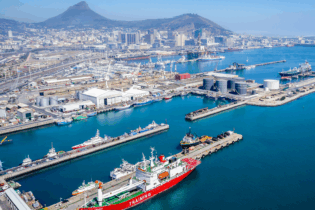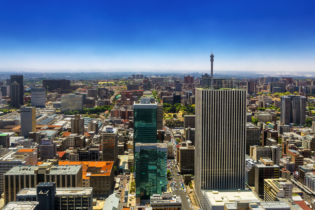“It’s good to see how the SA property industry can move to a more sustainable way of operating. The green features will improve the energy and environmental performance of the building, and will also ‘lock in’ superior long-term performance for them as investors and tenants. This achievement aligns with the City Of Tshwane’s strategic objective of achieving ‘sustainable communities’.” Executive Mayor of Tshwane, Councillor Kgosientso Ramokgopa
Engineering, management and specialist technical services group Aurecon has a new home. Their Lynnwood Bridge Office Park building, situated just off of the N1 highway, houses approximately 1 000 of their Tshwane staff and is a celebration of green-minded design and construction. These offices have been registered with the Green Building Council of South Africa for a GreenStar SA – [Office Design v1, Office Design v1] rating, with the aim of achieving a 4 star GreenStar SA rating. The engineering company is a silver founding member of the Green Building Council of South Africa (GBCSA), an organisation which promotes, encourages and facilitates green building in the South African property and construction industries. Their sponsorship of the council’s efforts confirms their support of transformation in industry and affirms our commitment to playing a leading role in promoting environmentally sustainable development. Apart from their affiliation with the GBCSA, Aurecon’s CEO, Gustav Rohde, says that ‘going green’ has its operational benefits too, including a more productive workforce and reduced running costs in terms of electricity and water usage, amongst others. WetlandAs the developer and co-owner of the building, Atterbury Property was responsible for the project management on the entire project, which forms part of their new 73 000 m² Lynnwood Bridge precinct. Aurecon was responsible for all the engineering design disciplines on the project. Having gained vast experience on similar projects, including Phase II of Nedbank’s head office in Sandton, which was certified as South Africa’s first Green Star SA building, the group was certainly ready for the challenge. “From the onset, we knew it wouldn’t be an easy task,” comments Aurecon’s national green building expert, Martin Smith. Conventionally, green buildings aren’t allowed to be built within 100 m of a wetland, yet the site allocated to Aurecon fell within 100 m of the Moreleta Spruit, which is classified as a wetland.
“There are good reasons for this rule,” explains Martin. “Potentially harmful water run-off from buildings can negatively affect the surrounding flora and fauna.” This led the entire project team to explore innovative ways of ensuring storm water run-off from their building wouldn’t in any way harm the near-by spruit. The solution, consisting of various species of plants affixed to the building’s northern car park façade, which acts as a natural filtration system, is a first for South Africa and led the GBCSA to reconsider their ruling.
Because a GreenStar SA rating involves so many different elements of sustainability, it was crucial that the company has a GreenStar SA Accredited Professional on their team. Smith, who fulfilled the role of this accredited professional, says: “A thorough understanding of each one of the GreenStar SA criteria, and how these interact with each other, doesn’t guarantee a successful rating, but it improves your chances of success because it enables you to unify the many sustainability concepts required on a single project.” Green building initiatives
A number of innovative green building initiatives have been applied at the new building, especially in the areas of reducing the consumption of electricity and water, as well as improving indoor environment quality for staff, reducing the impact of materials on the environment, improving building design and management, and encouraging alternate forms of transport.
Reducing the consumption of electricity
The building was designed with an energy efficient façade, consisting of high performance glazing, extensive external shading, insulated wall panels, and an insulted roof. Energy efficient light fittings with motion sensors have been used throughout, ensuring that lights are only turned on when a particular zone is occupied, and are predicted to save the company thousands of Rand in their overall electricity bill. In order to even further reduce the amount of lighting required, the building design ensures that a maximum amount of natural daylight is brought into the space, reducing the need for artificial lighting during the day. A main element of this design includes a central atrium with a reflective high level ceiling. This ceiling was designed to reflect daylight into the windows on the southern façade of the building, simultaneously maximising natural light and ensuring minimal solar heat gain as windows on this side of the building do not receive direct sunlight.
Another significant energy saver in the building’s Heating, Ventilation and Air Conditioning (HVAC) system which is extremely efficient and includes carbon dioxide (CO2) sensors to ensure that enough fresh air is supplied into the building. Its full economy cycle ensures free cooling is possible when outside conditions are favourable. In addition, a central chilled water plant circulates chilled water throughout the building. Importantly, all HVAC refrigerants and gaseous fire suppression systems used have an Ozone Depletion Potential (OPD) of zero. All HVAC systems containing refrigerants are contained in a moderately airtight enclosure and a refrigerant leak detection system has been installed to cover high-risk parts of the plant.
Importantly, sub-metering has been installed for all major energy uses. This will enable the building owner and/or facilities manager to verify that equipment and systems are operating as per their design specifications, and to identify areas where potential energy savings can be achieved. Reducing the consumption of waterThe amount of potable (fresh, drinking) water supplied to and consumed by the building has been reduced through a number of measures, including:
• Water efficient plumbing fixtures have been fitted onto taps and shower heads in all bathroom and shower areas to reduce the output volume of water supplied.
• All taps throughout the building have been fitted with flow restrictors so that no water is wasted through unnecessary usage.
• The potable water consumption for landscape irrigation has been reduced by more than 90% by making use of plants which require no water (xeriscaping), and indigenous plants which need a minimal amount of irrigation. The small portion of landscaping consisting of grass and flowerbeds will only be irrigated at night and will make use of soil moisture sensors so that only the necessary amount of water is used.
• A rainwater harvesting system will collect, store, treat and use large quantities of rain from the roof of the building and surrounding hard surfaces such as paving. This treated water will then be used in applications where potable water is conventionally (and unnecessarily) used, e.g. for flushing toilets. Potable or municipal water will be used in the remainder of applications within the building e.g. bathroom and kitchen taps, change room showers and tea bays.
• Only a portion of the storm water collected will be re-used for flushing; the remainder will be stored and slowly released through the innovative vertical filtering system.
• A water treatment system for the air conditioning condenser water has been installed to help maintain the efficiency of equipment by reducing the amount of scaling and algae growth in piping systems.
• Water meters are installed for all major water uses in the project, as well as an automated effective mechanism for monitoring water consumption data. This Building Management System will mean that water leaks can be identified and attended to straightaway.
Furthermore, each floor is fitted with a sprinkler system that has isolation valves or shut-off points for floor-by-floor testing (using recycled water). These measures ensure that large quantities of water are not wasted through routine fire system testing.
Reducing the impact of materials on the environment
Building materials were selected to minimise possible negative impacts on the environment. This included:
• Replacing 83% of the total cost of PVC content with alternative materials.
• Sourcing timber products used in the building and construction works from a Forest Stewardship Council certified forest.
• Ensuring 20% of the total contract value is represented by construction materials or products that have been sourced from within 400 km of the site, minimising excessive transportation emissions. Improving indoor environment quality
Staff flourish when they are placed in a comfortable and stimulating environment. The building offers the following:
• During modelling of the design, a high thermal comfort rating was achieved. Essentially, this means that, 98% of the time, 90% of the building’s occupants will feel comfortable and satisfied with the internal building temperature.
• Efforts have been made to ensure that a maximum amount of daylight enters the building. The unwanted effects of daylight glare have been minimised through control measures such as fixed shading devices and blinds on the windows which may be adjusted to shade the working plane from direct sun at desk height.
• Exceeding statutory ventilation requirements by 150%.
• The CO2 levels are carefully monitored and controlled to optimise the indoor air quality.
• The HVAC systems will operate on full fresh air when outside conditions are favourable.
• High frequency ballasts were installed in over 95% of the office Useable Area (UA) to eradicate the flickering effects of fluorescent lighting, which often causes headaches. This will also serve to improve the efficiency of the lighting.
• To limit the amount of Volatile Organic Compounds (VOCs) in the air, interior finishings such as carpets, paints, adhesives and sealants with low VOC emissions were used.
• Within the general office space, internal noise resulting from the building services and ambient sound levels has been reduced by using materials with a sufficient sound insulation level.
• All composite wood products have low formaldehyde emissions.
• The building includes a dedicated tenant’s exhaust riser system which eliminates harmful pollutants from the printing areas.
• High performance glass will limit the noise from the adjacent highway and ensure maximum thermal comfort.
Improving building design and management
The building owner will implement tuning of all building systems. Monthly monitoring will be undertaken and the outcomes will be reported to the building owner quarterly to allow corrective action to be taken. Full re-commissioning will be undertaken 12 months after practical completion. These initiatives will ensure that the building systems perform optimally, in the manner in which they were designed.
Encouraging alternate forms of transport
In order to encourage alternate forms of transport, 43 of the 844 parking spaces are dedicated solely for the use of car-pool vehicles, car share vehicles, hybrid or other alternative fuel vehicles. In addition, 76 secure bicycle storage racks have been provided, along with showers, changing facilities, and secure lockers. Visitor bicycle parking has also been provided. “It’s important to realise that a green building is a long-term commitment,” comments Rohde. “What we set out to achieve is the creation of an office which doesn’t harm the natural landscape which surrounds it, and benefits the people who use it. I believe we’ve succeeded in achieving this vision.”







